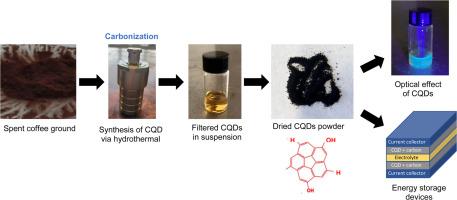利用废咖啡渣绿色合成的碳量子点在 EDLC 电极中的应用表征
IF 3.8
Q2 CHEMISTRY, PHYSICAL
引用次数: 0
摘要
本研究采用水热法从废咖啡渣中绿色合成碳量子点(CQDs),为纳米材料的生产提供了一种环保、经济、直接的方法。合成的碳量子点粒径在 1.6 纳米到 4.4 纳米之间,具有显著的荧光特性,根据咖啡来源的不同,量子产率分别为 37.0%、54.3% 和 63.3%。包括 XRD、FTIR、SEM、TEM 和 BET 在内的表征技术证实了这些 CQDs 在结构上适用于储能应用。它们的电化学性能通过循环伏安法(CV)、电静态充放电法(GCD)和电化学阻抗光谱法(EIS)进行了评估。在测试的 CQDs 中,从废弃的 Liberica 咖啡粉(中度烘焙)中提取的 CQDs 表现出卓越的性能,其放电比电容为 97.5 F/g,能量密度为 4.3 Wh/kg,在 0.5 A/g 的电流密度下,功率密度为 130.6 W/kg。此外,它们还表现出可接受的内阻(Ra = 0.01 kΩ,Rab = 16.9 kΩ),这表明它们具有良好的电荷转移特性。这些结果表明,从废弃咖啡渣中提取的 CQDs 具有更强的储能潜力。这些发现不仅突显了其优异的电化学性能,还证明了生物质废弃物作为先进储能应用的宝贵资源的可行性,促进了可持续的生态友好型技术的发展。本文章由计算机程序翻译,如有差异,请以英文原文为准。

Characterization of green-synthesized carbon quantum dots from spent coffee grounds for EDLC electrode applications
This study investigates the green synthesis of carbon quantum dots (CQDs) from spent coffee grounds using a hydrothermal method, offering an eco-friendly, cost-effective, and straightforward approach to nanomaterial production. The synthesized CQDs, with particle sizes ranging from 1.6 to 4.4 nm, exhibited notable fluorescence, achieving quantum yields of 37.0 %, 54.3 %, and 63.3 % depending on the coffee source. Characterization technique, including XRD, FTIR, SEM, TEM, and BET, confirmed their structural suitability of these CQDs for energy storage applications. Their electrochemical performance was evaluated through cyclic voltammetry (CV), galvanostatic charge-discharge (GCD), and electrochemical impedance spectroscopy (EIS). Among the CQDs tested, those derived from spent Liberica coffee ground (medium roasted) demonstrated superior performance, with a discharging specific capacitance of 97.5 F/g, an energy density of 4.3 Wh/kg, and a power density of 130.6 W/kg at a current density of 0.5 A/g. Additionally, they exhibited acceptable internal resistance (Ra = 0.01 kΩ and Rab = 16.9 kΩ), indicating favourable charge transfer characteristics. These results underscore the enhanced energy storage potential of CQDs derived from spent coffee grounds. The findings not only highlight the excellent electrochemical performance but also support the viability of biomass waste as a valuable resource for advanced energy storage applications, promoting sustainable, eco-friendly technologies.
求助全文
通过发布文献求助,成功后即可免费获取论文全文。
去求助
来源期刊

Chemical Physics Impact
Materials Science-Materials Science (miscellaneous)
CiteScore
2.60
自引率
0.00%
发文量
65
审稿时长
46 days
 求助内容:
求助内容: 应助结果提醒方式:
应助结果提醒方式:


